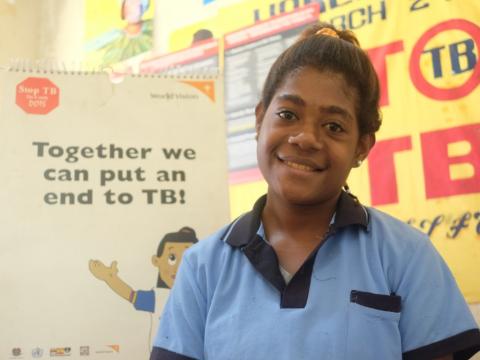STOP TB Strategy in Papua New Guinea

In 2013 around 2,400 people in Papua New Guinea died from a preventable and curable disease called Tuberculosis.
Consistent support from family members, health facilities, and communities play a crucial role in the prevention and treatment of TB. However, due to weak capacity and major shortage of health staff, TB clinics and laboratories in the country are hardpressed with meeting even the minimum government standards of quality TB diagnosis and care. The crucial follow-on treatment is also weak due to the lack of TB treatment supporters providing directly observed treatment to TB patients.
With assistance from World Vision Papua New Guinea, and funding support from The Global Fund and World Vision Australia, the National Tuberculosis Program (NTP) is building the capacity of 28 of its least performing TB clinics located in nine of its highest TB-burden provinces in the country. These clinics contribute to more than half of the TB cases reported nationwide.
World Vision deployed Liaison Officers in each of the priority TB clinics to provide all-around assistance to health staff and enable greater community support for TB patients. Liason Officers have led TB education sessions for communities and workplaces, organized monthly meetings with TB patients and treatment supporters, helped health staff gather and transport quality sputum specimen for immediate diagnosis, and ensured steady supply of TB drugs for patients, among others.
World Vision is also helping NTP re-energize its TB treatment supporters program to enable active TB case finding and consistent provision of directly observed treatment for TB patients. The effort is being pilot-tested in three provinces, namely Madang, Morobe, and the National Capital District.
As a sustainability measure, World Vision helped recruit and deploy staff at the National Department of Health and provincial health offices to provide coordination support for trainings; improvement in TB diagnosis (eg. roll-out of GeneXpert, perform TB culture, strengthening TB microscopy quality assurance); procurement and supply chain management of anti-TB drugs to ensure availability and access to medicines; and monitoring, supervision and evaluation.
This integrated approach has gradually yielded gains for the TB program as evidenced by 29,000 cases reported in 2015, reduction of people dropping out of treatment due to weak follow-up from 20% in 2013 to 16% in 2015; and increase in the number of people completing their treatment from 68% in 2013 to 70% in 2015 not only in priority sites but nationwide.
Madang Province – Jamilah, 15, received her daily TB treatment in one of the priority TB clinics supported by World Vision. Through consistent medication and care from the clinic staff, she defeated TB. “I want to be a nurse someday and help people,” she shared. “I really wanted to get well, so I came to the clinic everyday.”
National Capital District – Jennifer, 38, TB treatment supporter is proud to have assisted around 50 TB patients complete their medication including daughter Anna Mora, 23. “When I learned I had TB, I cried. I felt ashamed and afraid that my family and friends will shun me,” said Anna. “But my mother comforted me and assured me that TB can be cured and that I have to take my medicine everyday. I wouldn’t have done it without my mama’s support.” she beamed.
National Capital District – World Vision Liaison Officer Teresa Koriatsi (left) works with a health facility officer to update TB patients files.
National Capital District – World Vision Regional Coordinator Valda Kereu (center) conducts a monitoring visit together with an officer from the health department.
Learn more about World Vision's Tuberculosis Programming Across The Globe: http://www.wvi.org/health/TB



